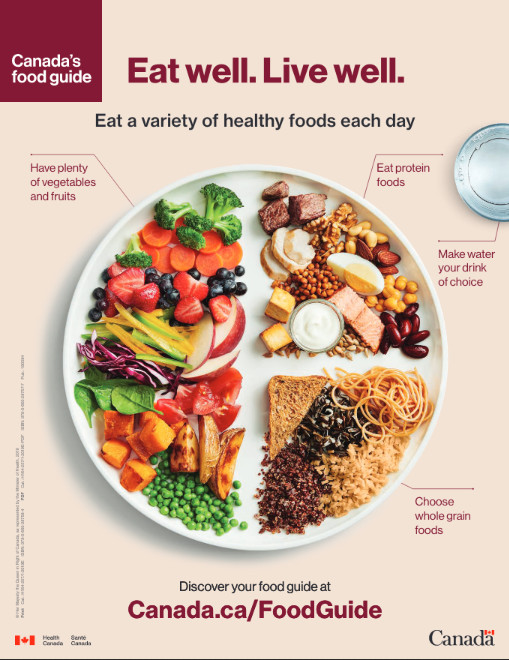Heart Healthy Changes to Canada’s Food Guide
 Canada’s Food Guide has gone through an overhaul, and the result has some great new recommendations to help keep Canadian Hearts Healthy!
Canada’s Food Guide has gone through an overhaul, and the result has some great new recommendations to help keep Canadian Hearts Healthy!
What’s different:
There has been a shift from the four food groups we are used to with recommended servings in each, to a more simple “pattern of eating” approach. The food guide recommends filling ½ of your plate with a variety of fruits and vegetables, ¼ of your plate with whole grain choices, and ¼ of your plate with healthy protein options. It’s about how you eat the majority of the time that makes the most impact. Notice here that dairy is not a stand alone food group anymore, but YES, it still does exist, just as part of the protein section. The re-naming of Meats & Alternatives, to simply protein is to take some of the emphasis off of meat, and instead towards choosing more plant based protein choices.
How this impacts your heart:
As the Food Guide states: “Dietary choices made on a regular basis form a person’s pattern of eating. Over time, patterns of eating can lead to better or worse health outcomes.”
With this is mind; the creators have looked at the evidence that reducing saturated fat in your diet lowers your LDL (“bad”) cholesterol. Which is why they are encouraging Canadians to eat less meat, as this is where most of the saturated fat in our diets come from. They are encouraging Canadians to look at plant based protein options instead, which have far less saturated fats as well as other heart health benefits! YAY!
But what’s really great, is the understanding that the real impact in reducing your heart disease risk and mortality is by REPLACING saturated fat with polyunsaturated fats. When you eat, the various nutrients in the foods on your plate impact each other, and the way our body is then affected. What has been realized is that simply taking out saturated fat doesn’t do the trick. What does however, is replacing those saturated fats with polyunsaturated fats. There are two types of unsaturated fats, poly & mono. Both are much better choices than saturated fats, but when used as a replacement, polyunsaturated fats, have been scientifically shown to reduce your risk of heart disease and mortality.
Below is a guideline from Canada’s Food guide along with their rationale:
Guideline 1
Nutritious foods are the foundation for healthy eating.
- Vegetables, fruit, whole grains, and protein foods should be consumed regularly. Among protein foods, consume plant-based more often.
- Protein foods include legumes, nuts, seeds, tofu, fortified soy beverage, fish, shellfish, eggs, poultry, lean red meat including wild game, lower fat milk, lower fat yogurts, lower fat kefir, and cheeses lower in fat and sodium.
- Foods that contain mostly unsaturated fat should replace foods that contain mostly saturated fat.
- Water should be the beverage of choice.
Heath Canada’s Rationale behind replacing saturated fats:
Health Canada recommends replacing foods that contain mostly saturated fat with foods that contain mostly unsaturated fat to promote cardiovascular health. The type of fat consumed over time is more important for health than the total amount of fat consumed.
There is convincing evidence that lowering the intake of saturated fat by replacing it with unsaturated fat (that is, poly- or mono-unsaturated fat) decreases total and LDL-cholesterol.1 , 2,18 –22 Elevated LDL – cholesterol is a well-established risk factor for cardiovascular disease that has affected about 1 in 5 adult Canadians in 2012/2013.
Replacing saturated fat with polyunsaturated fat can also lower the risk of cardiovascular disease.
Further, limiting the intake of foods in which the fat is mostly saturated, while choosing foods in which the fat is mostly unsaturated is a common feature of patterns that have been shown to have beneficial effects on health.1–6
Notice the focus on “patterns of eating”? As I mentioned before, one of the thoughts being considered here is how you eat over the long term, most of the time. “Cardiovascular disease is a serious public health concern in Canada. Almost 50% of deaths from cardiovascular disease were attributed to dietary risks in 2017.” (Health Canada) What is really being hammered home here is the idea that if you eat a regular intake of vegetables, fruits, whole grains, and healthy proteins, this eating pattern will have a protective effect on reducing the risk of cardiovascular disease. The various nutrients you receive from each food will work together to keep your heart healthy.
- Association between increased intakes of vegetables and fruit and decreased cardiovascular disease risk
- Association between diets high in nuts and lowered cardiovascular risk factors
- Association between diets high in soy protein and lowered cardiovascular risk factors
- Association between diets high in viscous soluble fibre such as oats and lowered cardiovascular risk factors
- Association between increased intakes of total dietary fibre and decreased risk of cardiovascular disease, colon cancer, and type 2 diabetes
So to end this post for today. I will finish by encouraging you to eat the rainbow of colors in all vegetables and fruits, choose whole grains, and choose unsaturated fats as a replacement to saturated fats. Also try plant based proteins more often like nuts & legumes, or at least stick more towards fish, chicken and turkey, vs beef & pork. And finally.. with the other half of the food guide I didn’t get into mentioning.. enjoy eating! Take your time. Cook & eat with family & friends. Nourish your soul as well as your body.
Polyunsaturated food options:
- Fish (Salmon, Mackerel, Albacore Tuna, Herring, Trout)
- Walnuts
- Chia Seeds
- Sunflower, safflower, flax, and corn oil
- Soybeans
- Sunflower seeds
Much Love,
Shawna Cook
Clinical Exercise Physiologist
Pulse Cardiac Health
